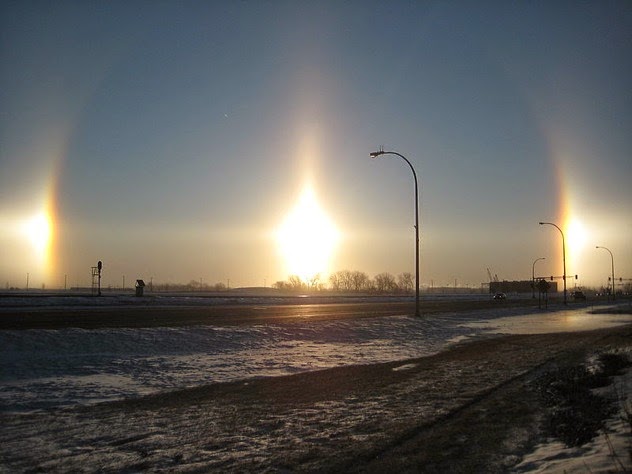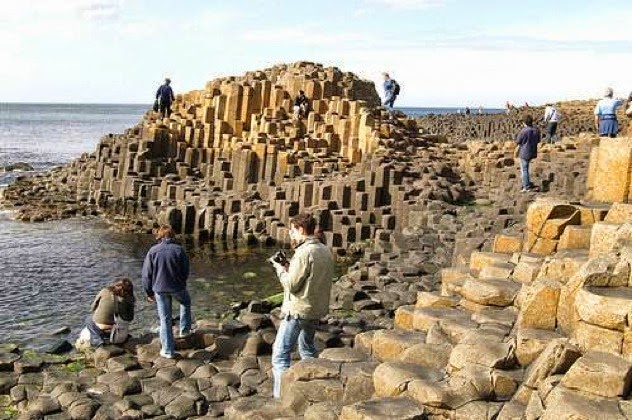Sometimes Nature Is Awesome. Other Times, It’ll Scare The Life Out Of You. Like This.
If you’re a skeptic, prepare to have your socks knocked off. The insane photographs you see below aren’t photoshop or the creation of a science fiction artist. They are actually very real and very natural occurrences in nature.
But that doesn’t stop them from being hellishly scary.
1. Supercells: Supercells are gigantic, spinning storms that have the tendency to be extremely destructive and create tornadoes. Supercells are the most dangerous of the four major storm types. They’re the most rare, but they are also insanely scary to look at… so if you see one coming, drive the other way.

2. Penitentes: Ice can do a lot of funky things in nature and these formations are called penitentes. Each shard can grow up to 13 feet tall. They are formed in high-altitude areas with low humidity. They occur in such rare places with extreme weather that you’ll never have to worry about running into one of these giant ice shards.
![2. 2. Penitentes: Ice can do a lot of funky things in nature and these formations are called penitentes. Each shard can grow up to 13 feet tall. They are formed in high-altitude areas with low humidity. They occur in such rare places with extreme weather that you’ll never have to worry about running into one of these giant ice shards. - Sometimes Nature Is Awesome. Other Times, It’ll Scare The Life Out Of You. Like This.]()
3. Brinicles: When the surface of the ocean freezes, cold and salty seawater is gathered on the underside of the ice. This mixture of brine is denser than the seawater below. The dense brine falls through the normal seawater, but it’s so cold that it freezes the water around it… causing a weird sea icicle.
![3. Brinicles: When the surface of the ocean freezes, cold and salty seawater is gathered on the underside of the ice. This mixture of brine is denser than the seawater below. The dense brine falls through the normal seawater, but it’s so cold that it freezes the water around it… causing a weird sea icicle. - Sometimes Nature Is Awesome. Other Times, It’ll Scare The Life Out Of You. Like This.]()
4. Volcanic lightning: Volcanic lightning occurs when a lightning storm takes place in the middle of a volcanic eruption. The theory as to why this happens is that when the volcano erupts, it projects positively-charged debris into the atmosphere. These charges then react with negative charges already present, which results in a bolt of lightning.

5. Fire rainbows: These colorful clouds can usually be seen in the summers of middle-latitude areas, such as most of the United States. They are a large halo of refracted light that occur when the sun is at least 58 degrees above the horizon and when there are cirrus clouds in the sky that are filled with plate-shaped ice crystals. The halos tend to be so large that only small parts of them are seen by the naked eye (thus they look like tongues of fire). The proper name for a fire rainbow is a “circumhorizontal arc.”

6. Sun dogs: This is a phenomenon that his actually another massive light refraction because of crystals in the atmosphere. Sun dogs appear to circle the sun and appear as two distinctive bright spots on either side of the halo. This phenomena can even make it look like there are three suns in the sky.

7. Waterspouts: These are tornadoes that form over water and although they generally aren’t dangerous if you’re on land, their wind speeds do reach up to 190 miles (305 kilometers) per hour. So it’s safe to say that if you’re on a boat or living on the coast, you should probably do your best to avoid them.

8. Snow donuts: A snow donuts occurs when nature decides to roll up its own type of snow balls (litrally). These rare shapes are formed when a mass of snow either falls or is blown by the wind. If it manages to catch on to some other snow, the gravity/wind will roll it up into a snow donut. These only happen under rare weather conditions, so the chance of finding them in your back yard are slim.

9. Columnar Basalt: These huge and completely unique honeycomb formations are a result of lava flows cracking as they cool, in a perpendicular direction to the original flow. Columnar basalt clusters can be found all over the world and are always an impressive sight to be seen. Mother nature has a penchant for awesome geometric formations.

10. Ice flowers: These are frost formations that look like delicate flowers. They are formed when ice particles collect around the base of certain plants and types of wood. When the temperature outside the plant is below freezing (but the inside is warmer), water is sucked outward and is frozen. The ice builds upon itself, causing “petals” of ice to form.

Remind me never to mess with Mother Nature.
Source: Listverse Via Viral Nova
But that doesn’t stop them from being hellishly scary.

2. Penitentes: Ice can do a lot of funky things in nature and these formations are called penitentes. Each shard can grow up to 13 feet tall. They are formed in high-altitude areas with low humidity. They occur in such rare places with extreme weather that you’ll never have to worry about running into one of these giant ice shards.
3. Brinicles: When the surface of the ocean freezes, cold and salty seawater is gathered on the underside of the ice. This mixture of brine is denser than the seawater below. The dense brine falls through the normal seawater, but it’s so cold that it freezes the water around it… causing a weird sea icicle.
4. Volcanic lightning: Volcanic lightning occurs when a lightning storm takes place in the middle of a volcanic eruption. The theory as to why this happens is that when the volcano erupts, it projects positively-charged debris into the atmosphere. These charges then react with negative charges already present, which results in a bolt of lightning.

5. Fire rainbows: These colorful clouds can usually be seen in the summers of middle-latitude areas, such as most of the United States. They are a large halo of refracted light that occur when the sun is at least 58 degrees above the horizon and when there are cirrus clouds in the sky that are filled with plate-shaped ice crystals. The halos tend to be so large that only small parts of them are seen by the naked eye (thus they look like tongues of fire). The proper name for a fire rainbow is a “circumhorizontal arc.”

6. Sun dogs: This is a phenomenon that his actually another massive light refraction because of crystals in the atmosphere. Sun dogs appear to circle the sun and appear as two distinctive bright spots on either side of the halo. This phenomena can even make it look like there are three suns in the sky.

7. Waterspouts: These are tornadoes that form over water and although they generally aren’t dangerous if you’re on land, their wind speeds do reach up to 190 miles (305 kilometers) per hour. So it’s safe to say that if you’re on a boat or living on the coast, you should probably do your best to avoid them.

8. Snow donuts: A snow donuts occurs when nature decides to roll up its own type of snow balls (litrally). These rare shapes are formed when a mass of snow either falls or is blown by the wind. If it manages to catch on to some other snow, the gravity/wind will roll it up into a snow donut. These only happen under rare weather conditions, so the chance of finding them in your back yard are slim.

9. Columnar Basalt: These huge and completely unique honeycomb formations are a result of lava flows cracking as they cool, in a perpendicular direction to the original flow. Columnar basalt clusters can be found all over the world and are always an impressive sight to be seen. Mother nature has a penchant for awesome geometric formations.

10. Ice flowers: These are frost formations that look like delicate flowers. They are formed when ice particles collect around the base of certain plants and types of wood. When the temperature outside the plant is below freezing (but the inside is warmer), water is sucked outward and is frozen. The ice builds upon itself, causing “petals” of ice to form.

Remind me never to mess with Mother Nature.
Source: Listverse Via Viral Nova
Related Posts:
Sometimes Nature Is Awesome. Other Times, It’ll Scare The Life Out Of You. Like This.
 Reviewed by Eli Snow
on
6:24 AM
Rating:
Reviewed by Eli Snow
on
6:24 AM
Rating:
 Reviewed by Eli Snow
on
6:24 AM
Rating:
Reviewed by Eli Snow
on
6:24 AM
Rating:

 If you’re a skeptic, prepare to have your socks knocked off. The insane photographs you see below aren’t photoshop or the creation of a science fiction artist. They are actually very real and very natural occurrences in nature.
If you’re a skeptic, prepare to have your socks knocked off. The insane photographs you see below aren’t photoshop or the creation of a science fiction artist. They are actually very real and very natural occurrences in nature.+-+This+is+Alaska's+Muir+Glacier+&+Inlet+in+1895.+Get+Ready+to+Be+Shocked+When+You+See+What+it+Looks+Like+Now..jpg)



+Storm+clouds+in+Romania.+-+These+Clouds+Are+Scary+As+Hell.+Better+Bring+An+Umbrella..jpg)



No comments